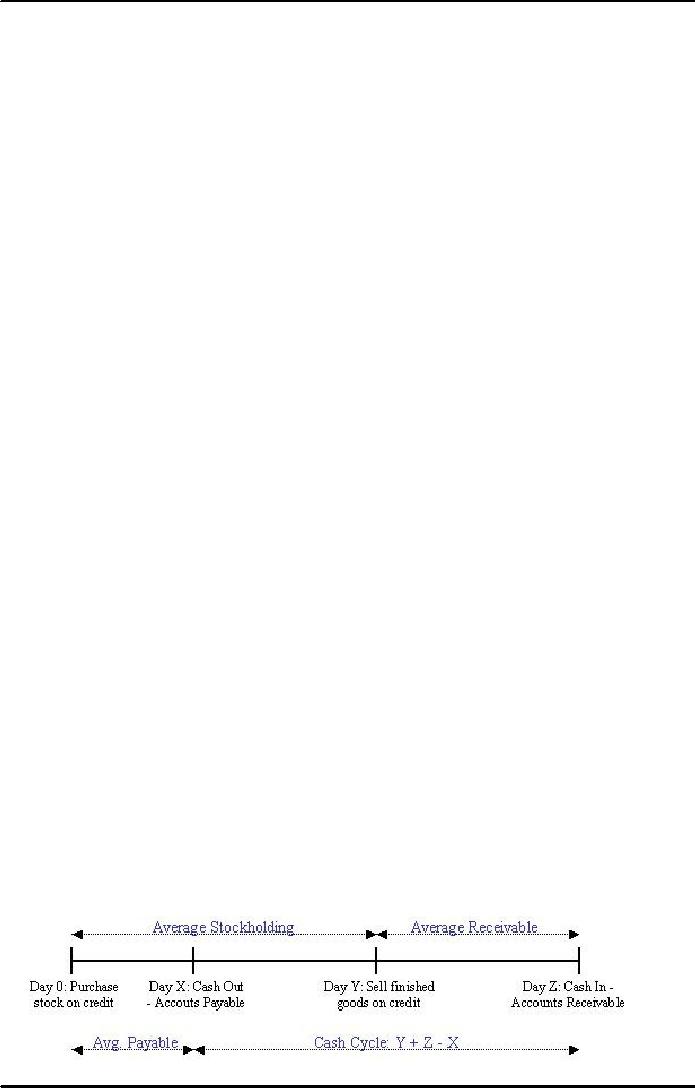 |

Corporate
Finance FIN 622
VU
Lesson
25
CASH
FLOW STATEMENT & WORKING
CAPITAL MANAGEMENT
The
following topics will be
discussed in this lecture.
Cash
flow statement
Direct
method
Indirect
method
Working
capital management
Cash
and operating cycle
Cash
Flow Statement
The
cash flow statement analyses
changes in cash and cash
equivalents during a period.
Cash and cash
equivalents
comprise cash on hand and
demand deposits, together with
short-term, highly liquid
investments
that are readily convertible to a
known amount of cash, and
that are subject to an
insignificant
risk of
changes in value. Guidance notes indicate
that an investment normally meets the
definition of a cash
equivalent
when it has a maturity of
three months or less from the
date of acquisition. Equity
investments
are
normally excluded, unless they
are in substance a cash equivalent
(e.g. preferred shares acquired
within
three
months of their specified redemption
date). Bank overdrafts which are
repayable on demand
and
which
form an integral part of an enterprise's
cash management are also
included as a component of cash
and
cash equivalents. [IAS
7.7-8]
Presentation
of the Cash Flow
Statement:
Cash
flows must be analyzed
between operating, investing and
financing activities. [IAS
7.10]
Key
principles specified by IAS 7 for the
preparation of a cash flow statement
are as follows:
� Operating
Activities are
the main revenue-producing activities of the
enterprise that are
not
investing or
financing activities, so operating cash
flows include cash received
from customers and
cash
paid to suppliers and employees
[IAS 7.14]
� Investing
Activities are
the acquisition and disposal of long-term
assets and other
investments
that
are not considered to be
cash equivalents [IAS
7.6]
� Financing
Activities are
activities that alter the equity capital
and borrowing structure of
the
enterprise
[IAS 7.6]
� interest
and dividends received and paid
may be classified as operating, investing, or
financing cash
flows,
provided that they are
classified consistently from
period to period [IAS
7.31]
� cash
flows arising from taxes on
income are normally
classified as operating, unless they can
be
specifically
identified with financing or investing
activities [IAS 7.35]
� for
operating cash flows, the direct method of
presentation is encouraged, but the
indirect method
is
acceptable [IAS 7.18]
The
direct
method shows
each major class of gross
cash receipts and gross
cash payments. The
operating
cash flows section of the
cash flow statement under the direct
method would appear
something
like this:
Cash
receipts from
customers
xx,xxx
Cash
paid to suppliers
xx,xxx
Cash
paid to employees
xx,xxx
Cash
paid for other operating
expenses
xx,xxx
Interest
paid
xx,xxx
Income
taxes paid
xx,xxx
Net
cash from operating
activities
xx,xxx
The
indirect
method adjusts
accrual basis net profit or
loss for the effects of
non-cash
transactions.
The operating cash flows
section of the cash flow
statement under the indirect
method
would appear something like
this:
Profit
before interest and income
taxes
xx,xxx
Add
back depreciation
xx,xxx
Add
back amortization of goodwill
xx,xxx
83

Corporate
Finance FIN 622
VU
Increase
in receivables
xx,xxx
Decrease
in inventories
xx,xxx
Increase
in trade payables
xx,xxx
Interest
expense
xx,xxx
Less
Interest accrued but not
yet paid
xx,xxx
Interest
paid
xx,xxx
Income
taxes paid
xx,xxx
Net
cash from operating
activities
xx,xxx
�
Cash
flows relating to extraordinary items should be
classified as operating, investing or
financing
as appropriate
and should be separately disclosed
[IAS 7.29]
� The
exchange rate used for
translation of transactions denominated in a foreign
currency and the
cash
flows of a foreign subsidiary should be
the rate in effect at the date of the
cash flows [IAS
7.25]
� Cash
flows of foreign subsidiaries should be
translated at the exchange rates
prevailing when the
cash
flows took place [IAS
7.26]
� As
regards the cash flows of
associates and joint
ventures, where the equity method is
used, the
cash
flow statement should report
only cash flows between the
investor and the investee;
where
proportionate
consolidation is used, the cash flow
statement should include the venturer's
share of
the
cash flows of the investee
[IAS 7.37-38]
� Aggregate
cash flows relating to acquisitions
and disposals of subsidiaries
and other business
units
should be
presented separately and
classified as investing activities, with
specified additional
disclosures.
The aggregate cash paid or
received as consideration should be reported net of
cash
and
cash equivalents acquired or
disposed of [IAS
7.39]
� Cash
flows from investing and
financing activities should be reported gross by major
class of cash
receipts
and major class of cash
payments except for the
following cases, which may
be reported on
a net
basis: [IAS 7.22-24]
cash
receipts and payments on behalf of
customers (for example,
receipt and repayment
of
demand deposits by banks,
and receipts collected on behalf of
and paid over to the
owner of a
property)
cash
receipts and payments for
items in which the turnover is quick, the
amounts are
large,
and the maturities are short,
generally less than three
months (for example,
charges
and
collections from credit card customers,
and purchase and sale of
investments)
cash
receipts and payments relating to
fixed maturity
deposits
cash
advances and loans made to
customers and repayments
thereof
� investing
and financing transactions
which do not require the use of
cash should be excluded
from
the
cash flow statement, but
they should be separately disclosed
elsewhere in the financial
statements
[IAS 7.43]
� the
components of cash and cash
equivalents should be disclosed, and a
reconciliation presented to
amounts
reported in the balance sheet [IAS
7.45]
� the amount of
cash and cash equivalents
held by the enterprise that is
not available for use by
the
group
should be disclosed, together with a
commentary by management [IAS
7.48]
Defining
Working Capital
The
term working capital refers to the amount
of capital which is readily available to an
organization. That
is,
working capital is the difference between
resources in cash or readily convertible
into cash (Current
Assets)
and organizational commitments for
which cash will soon be
required (Current Liabilities).
Current
Assets are resources which
are in cash or will soon be
converted into cash in "the
ordinary course
of
business".
Current
Liabilities are commitments
which will soon require cash
settlement in "the ordinary
course of
business".
Thus:
WORKING
CAPITAL = CURRENT ASSETS - CURRENT
LIABILITIES
In a
department's Statement of Financial Position,
these components of working
capital are reported under
the
following headings:
84

Corporate
Finance FIN 622
VU
Current
Assets
� Liquid
Assets (cash and bank
deposits)
� Inventory
� Debtors
and Receivables
Current
Liabilities
� Bank
Overdraft
� Creditors
and Payables
� Other
Short Term Liabilities
The
Importance of Good Working
Capital Management
Working
capital constitutes part of the
Crown's investment in a department.
Associated with this is an
opportunity
cost to the Crown. (Money invested in
one area may "cost"
opportunities for investment in
other
areas.) If a department is operating with
more working capital than is
necessary, this over-investment
represents
an unnecessary cost to the Crown.
From a
department's point of view, excess
working capital means operating
inefficiencies. In addition,
unnecessary
working capital increases the amount of
the capital charge which
departments are required to
meet
from 1 July 1991.
Approaches
to Working Capital
Management
The
objective of working capital management
is to maintain the optimum balance of
each of the working
capital
components. This includes making
sure that funds are held as
cash in bank deposits for as
long as
and in
the largest amounts possible, thereby
maximizing the interest earned. However,
such cash may
more
appropriately be
"invested" in other assets or in
reducing other liabilities.
Working
capital management takes
place on two levels:
� Ratio
analysis can be used to
monitor overall trends in
working capital and to
identify areas
requiring
closer management (see
Chapter Three).
� The
individual components of working
capital can be effectively
managed by using
various
techniques
and strategies (see Chapter
Four).
When
considering these techniques
and strategies, departments
need to recognize that each
department has
a unique
mix of working capital
components. The emphasis
that needs to be placed on
each component
varies
according to department. For example,
some departments have significant
inventory levels;
others
have
little if any
inventory.
Furthermore,
working capital management is
not an end in itself. It is an integral
part of the department's
overall
management. The needs of
efficient working capital
management must be considered in
relation to
other
aspects of the department's financial and
non-financial performance.
Cash
Operating Cycle
Cash
Conversion Cycle, also
known as the asset conversion cycle, net
operating cycle, working
capital
cycle
or just cash cycle, is used
in the financial analysis of a business.
The higher the number, the longer a
firm's
money is tied up in business operations
and unavailable for other
activities such as investing.
The
cash
conversion cycle is the number of days
between paying for raw
materials and receiving cash
from
selling
goods made from that
raw material.
� Cash
Conversion Cycle = Average Stockholding
Period (in days) + Average
Receivables Processing
Period
(in days) - Average Payables
Processing Period (in
days)
with:
� Average
Stockholding Period (in days) =
Closing Stock / Average
Daily Purchases
� Average
Receivables Processing Period (in
days) = Accounts Receivable / Average
Daily Credit
Sales
� Average
Payable Processing Period (in
days) = Accounts Payable / Average
Daily Credit
Purchases
85

Corporate
Finance FIN 622
VU
A short
cash conversion cycle indicates
good working capital
management. Conversely, a long
cash
conversion
cycle suggests that capital
is tied up while the business
waits for customers to
pay.
It is
possible for a business to
have a negative cash conversion
cycle, i.e. receiving customer
payments
before having to
pay suppliers. Examples are
typically companies that employ
Just in Time practices such
as
Dell,
and companies that buy on
extended credit terms and
sell for cash, such as
Tesco.
The
longer the production process, the more
cash the firm must keep
tied up in inventories. Similarly, the
longer it
takes customers to pay their
bills, the higher the value of accounts
receivable. On the other hand,
if
a firm
can delay paying for its
own materials, it may reduce
the amount of cash it needs. In other
words,
accounts
payable reduce net working
capital.
86
Table of Contents:
- INTRODUCTION TO SUBJECT
- COMPARISON OF FINANCIAL STATEMENTS
- TIME VALUE OF MONEY
- Discounted Cash Flow, Effective Annual Interest Bond Valuation - introduction
- Features of Bond, Coupon Interest, Face value, Coupon rate, Duration or maturity date
- TERM STRUCTURE OF INTEREST RATES
- COMMON STOCK VALUATION
- Capital Budgeting Definition and Process
- METHODS OF PROJECT EVALUATIONS, Net present value, Weighted Average Cost of Capital
- METHODS OF PROJECT EVALUATIONS 2
- METHODS OF PROJECT EVALUATIONS 3
- ADVANCE EVALUATION METHODS: Sensitivity analysis, Profitability analysis, Break even accounting, Break even - economic
- Economic Break Even, Operating Leverage, Capital Rationing, Hard & Soft Rationing, Single & Multi Period Rationing
- Single period, Multi-period capital rationing, Linear programming
- Risk and Uncertainty, Measuring risk, Variability of return–Historical Return, Variance of return, Standard Deviation
- Portfolio and Diversification, Portfolio and Variance, Risk–Systematic & Unsystematic, Beta – Measure of systematic risk, Aggressive & defensive stocks
- Security Market Line, Capital Asset Pricing Model – CAPM Calculating Over, Under valued stocks
- Cost of Capital & Capital Structure, Components of Capital, Cost of Equity, Estimating g or growth rate, Dividend growth model, Cost of Debt, Bonds, Cost of Preferred Stocks
- Venture Capital, Cost of Debt & Bond, Weighted average cost of debt, Tax and cost of debt, Cost of Loans & Leases, Overall cost of capital – WACC, WACC & Capital Budgeting
- When to use WACC, Pure Play, Capital Structure and Financial Leverage
- Home made leverage, Modigliani & Miller Model, How WACC remains constant, Business & Financial Risk, M & M model with taxes
- Problems associated with high gearing, Bankruptcy costs, Optimal capital structure, Dividend policy
- Dividend and value of firm, Dividend relevance, Residual dividend policy, Financial planning process and control
- Budgeting process, Purpose, functions of budgets, Cash budgets–Preparation & interpretation
- Cash flow statement Direct method Indirect method, Working capital management, Cash and operating cycle
- Working capital management, Risk, Profitability and Liquidity - Working capital policies, Conservative, Aggressive, Moderate
- Classification of working capital, Current Assets Financing – Hedging approach, Short term Vs long term financing
- Overtrading – Indications & remedies, Cash management, Motives for Cash holding, Cash flow problems and remedies, Investing surplus cash
- Miller-Orr Model of cash management, Inventory management, Inventory costs, Economic order quantity, Reorder level, Discounts and EOQ
- Inventory cost – Stock out cost, Economic Order Point, Just in time (JIT), Debtors Management, Credit Control Policy
- Cash discounts, Cost of discount, Shortening average collection period, Credit instrument, Analyzing credit policy, Revenue effect, Cost effect, Cost of debt o Probability of default
- Effects of discounts–Not effecting volume, Extension of credit, Factoring, Management of creditors, Mergers & Acquisitions
- Synergies, Types of mergers, Why mergers fail, Merger process, Acquisition consideration
- Acquisition Consideration, Valuation of shares
- Assets Based Share Valuations, Hybrid Valuation methods, Procedure for public, private takeover
- Corporate Restructuring, Divestment, Purpose of divestment, Buyouts, Types of buyouts, Financial distress
- Sources of financial distress, Effects of financial distress, Reorganization
- Currency Risks, Transaction exposure, Translation exposure, Economic exposure
- Future payment situation – hedging, Currency futures – features, CF – future payment in FCY
- CF–future receipt in FCY, Forward contract vs. currency futures, Interest rate risk, Hedging against interest rate, Forward rate agreements, Decision rule
- Interest rate future, Prices in futures, Hedging–short term interest rate (STIR), Scenario–Borrowing in ST and risk of rising interest, Scenario–deposit and risk of lowering interest rates on deposits, Options and Swaps, Features of opti
- FOREIGN EXCHANGE MARKET’S OPTIONS
- Calculating financial benefit–Interest rate Option, Interest rate caps and floor, Swaps, Interest rate swaps, Currency swaps
- Exchange rate determination, Purchasing power parity theory, PPP model, International fisher effect, Exchange rate system, Fixed, Floating
- FOREIGN INVESTMENT: Motives, International operations, Export, Branch, Subsidiary, Joint venture, Licensing agreements, Political risk